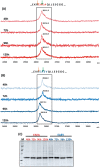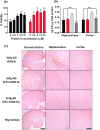Production of an anti-Aβ antibody fragment in Pichia pastoris and in vitro and in vivo validation of its therapeutic effect
- PMID: 28771492
- PMCID: PMC5542431
- DOI: 10.1371/journal.pone.0181480
Production of an anti-Aβ antibody fragment in Pichia pastoris and in vitro and in vivo validation of its therapeutic effect
Abstract
ScFv-h3D6 has been shown as an efficient therapy in the 3xTg-AD mouse model of Alzheimer's Disease. Because one of the major bottlenecks for the therapeutic uses of proteins produced in Escherichia coli is their potential contamination with endotoxins, LPS were extensively removed by a rather low-efficient, expensive, and time-consuming purification step. In addition, disulfide scrambling is favored in the reducing bacterial cytoplasm albeit the use of reductase deficient strains. To overcome these hurdles, as well as to improve the yield, the yeast Pichia pastoris, an endotoxin-free host system for recombinant protein production, has been used to produce scFv-h3D6, both in flask and in a fed-batch bioreactor. Comparison of the thermal stability of the obtained protein with that from E. coli showed no differences. Opposite to the case of the protein obtained from E. coli, no disulfide scrambled conformations or LPS traces were detected in that produced in P. pastoris. Cytotoxicity assays in SH-SY5Y neuroblastoma cell-cultures demonstrated that proteins from both expression systems were similarly efficient in precluding Aβ-induced toxicity. Finally, the 3xTg-AD mouse model was used to test the therapeutic effect of both proteins. Quantification of Aβ levels from cortex and hippocampus protein extracts by ELISA, and Aβ-immunohistochemistry, showed that both proteins reduced Aβ burden. This work demonstrates that scFv-h3D6 obtained from P. pastoris shows the same benefits as those already known for that obtained from E. coli, with multiple advantages in terms of recombinant production and safety.
Conflict of interest statement
Figures







Similar articles
-
Aβ-oligomer uptake and the resulting inflammatory response in adult human astrocytes are precluded by an anti-Aβ single chain variable fragment in combination with an apoE mimetic peptide.Mol Cell Neurosci. 2018 Jun;89:49-59. doi: 10.1016/j.mcn.2018.03.015. Epub 2018 Apr 3. Mol Cell Neurosci. 2018. PMID: 29625180
-
Effects of an Aβ-antibody fragment on Aβ aggregation and astrocytic uptake are modulated by apolipoprotein E and J mimetic peptides.PLoS One. 2017 Nov 20;12(11):e0188191. doi: 10.1371/journal.pone.0188191. eCollection 2017. PLoS One. 2017. PMID: 29155887 Free PMC article.
-
Pharmacokinetic parameters and mechanism of action of an efficient anti-Aβ single chain antibody fragment.PLoS One. 2019 May 31;14(5):e0217793. doi: 10.1371/journal.pone.0217793. eCollection 2019. PLoS One. 2019. PMID: 31150495 Free PMC article.
-
Gene and process level modulation to overcome the bottlenecks of recombinant proteins expression in Pichia pastoris.Curr Pharm Biotechnol. 2017;18(15):1200-1223. doi: 10.2174/1389201019666180329112827. Curr Pharm Biotechnol. 2017. PMID: 29595107 Review.
-
Escherichia coli and Pichia pastoris: microbial cell-factory platform for -full-length IgG production.Crit Rev Biotechnol. 2025 Feb;45(1):191-213. doi: 10.1080/07388551.2024.2342969. Epub 2024 May 26. Crit Rev Biotechnol. 2025. PMID: 38797692 Review.
Cited by
-
Phospholipase D1 Attenuation Therapeutics Promotes Resilience against Synaptotoxicity in 12-Month-Old 3xTg-AD Mouse Model of Progressive Neurodegeneration.Int J Mol Sci. 2023 Feb 8;24(4):3372. doi: 10.3390/ijms24043372. Int J Mol Sci. 2023. PMID: 36834781 Free PMC article.
-
Recombinant Antibody Fragments for Neurological Disorders: An Update.Curr Neuropharmacol. 2024;22(13):2157-2167. doi: 10.2174/1570159X21666230830142554. Curr Neuropharmacol. 2024. PMID: 37646225 Free PMC article. Review.
-
Cognitive Impairment in the 3xTg-AD Mouse Model of Alzheimer's Disease is Affected by Aβ-ImmunoTherapy and Cognitive Stimulation.Pharmaceutics. 2020 Oct 2;12(10):944. doi: 10.3390/pharmaceutics12100944. Pharmaceutics. 2020. PMID: 33023109 Free PMC article.
-
The mosaic puzzle of the therapeutic monoclonal antibodies and antibody fragments - A modular transition from full-length immunoglobulins to antibody mimetics.Leuk Res Rep. 2022 Jun 27;18:100335. doi: 10.1016/j.lrr.2022.100335. eCollection 2022. Leuk Res Rep. 2022. PMID: 35832747 Free PMC article.
-
Production of Therapeutic Single-Chain Variable Fragments (ScFv) in Pichia pastoris.Methods Mol Biol. 2022;2313:151-167. doi: 10.1007/978-1-0716-1450-1_8. Methods Mol Biol. 2022. PMID: 34478136
References
-
- Waldmann TA. Immunotherapy: past, present and future. Nat Med. 2003;9:269–77. doi: 10.1038/nm0303-269 - DOI - PubMed
-
- Hardy J, Selkoe DJ. The amyloid hypothesis of Alzheimer’s disease: progress and problems on the road to therapeutics. Science. 2002;297:353–6. doi: 10.1126/science.1072994 - DOI - PubMed
-
- Hardy J. Alzheimer’s disease: the amyloid cascade hypothesis: an update and reappraisal. J Alzheimers Dis. 2006;9 3 Suppl:151–3. - PubMed
-
- Walsh DM, Selkoe DJ. A beta oligomers—a decade of discovery. J Neurochem. 2007;101:1172–84. doi: 10.1111/j.1471-4159.2006.04426.x - DOI - PubMed
-
- Tomic JL, Pensalfini A, Head E, Glabe CG. Soluble fibrillar oligomer levels are elevated in Alzheimer’s disease brain and correlate with cognitive dysfunction. Neurobiol Dis. 2009;35:352–8. doi: 10.1016/j.nbd.2009.05.024 - DOI - PMC - PubMed
MeSH terms
Substances
LinkOut - more resources
Full Text Sources
Other Literature Sources
Molecular Biology Databases

